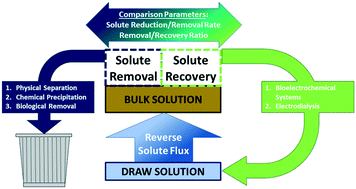当前位置:
X-MOL 学术
›
Environ. Sci.: Water Res. Technol.
›
论文详情
Our official English website, www.x-mol.net, welcomes your
feedback! (Note: you will need to create a separate account there.)
Reduction of reverse solute flux induced solute buildup in the feed solution of forward osmosis
Environmental Science: Water Research & Technology ( IF 3.5 ) Pub Date : 2019/12/04 , DOI: 10.1039/c9ew00775j Matthew Ferby 1, 2, 3, 4 , Shiqiang Zou 1, 4, 5, 6 , Zhen He 1, 2, 3, 4, 7
Environmental Science: Water Research & Technology ( IF 3.5 ) Pub Date : 2019/12/04 , DOI: 10.1039/c9ew00775j Matthew Ferby 1, 2, 3, 4 , Shiqiang Zou 1, 4, 5, 6 , Zhen He 1, 2, 3, 4, 7
Affiliation

|
Forward osmosis (FO) has shown advancement towards recovery of useful water from various waste streams. A major issue that arises is the accumulation of salts due to reverse solute flux (RSF) from a draw solution into a feed solution that can result in several negative effects such as decreased water flux and inhibition of biological activities. This paper aims to provide a concise discussion and analysis of methods that can help to alleviate the effects of solute buildup. New parameters, solute removal/recovery rate (SRR) and removal/recovery ratio (ReR), are proposed to help better define the performance of reducing solute buildup and employed in case studies to evaluate selected reduction methods. Solute removal can be accomplished by physical separation, chemical precipitation, and biological removal. Recovery of solutes, one step beyond removal, is discussed and demonstrated by using bioelectrochemical systems and electrodialysis as examples. This work has highlighted the concerns associated with solute buildup and will encourage further exploration of effective tools to mitigate solute buildup for improved performance of FO-based water/wastewater systems.
中文翻译:

减少正向渗透进料溶液中反向溶质通量引起的溶质积聚
正向渗透(FO)已显示出从各种废物流中回收有用水的进步。出现的主要问题是由于从抽提溶液到进料溶液中的反向溶质通量(RSF)导致盐的积累,这可能导致多种负面影响,例如水通量降低和生物活性抑制。本文旨在对有助于减轻溶质堆积效应的方法进行简要的讨论和分析。提出了新的参数,溶质去除/回收率(SRR)和去除/回收率(ReR),以帮助更好地定义减少溶质积聚的性能,并在案例研究中用于评估所选的还原方法。溶质的去除可以通过物理分离,化学沉淀和生物去除来完成。回收溶质,以生物电化学系统和电渗析为例,讨论并证明了除去除步骤以外的另一步骤。这项工作突出了与溶质积聚相关的担忧,并将鼓励进一步探索有效的工具来减轻溶质积聚,从而改善基于FO的水/废水系统的性能。
更新日期:2020-03-05
中文翻译:

减少正向渗透进料溶液中反向溶质通量引起的溶质积聚
正向渗透(FO)已显示出从各种废物流中回收有用水的进步。出现的主要问题是由于从抽提溶液到进料溶液中的反向溶质通量(RSF)导致盐的积累,这可能导致多种负面影响,例如水通量降低和生物活性抑制。本文旨在对有助于减轻溶质堆积效应的方法进行简要的讨论和分析。提出了新的参数,溶质去除/回收率(SRR)和去除/回收率(ReR),以帮助更好地定义减少溶质积聚的性能,并在案例研究中用于评估所选的还原方法。溶质的去除可以通过物理分离,化学沉淀和生物去除来完成。回收溶质,以生物电化学系统和电渗析为例,讨论并证明了除去除步骤以外的另一步骤。这项工作突出了与溶质积聚相关的担忧,并将鼓励进一步探索有效的工具来减轻溶质积聚,从而改善基于FO的水/废水系统的性能。











































 京公网安备 11010802027423号
京公网安备 11010802027423号